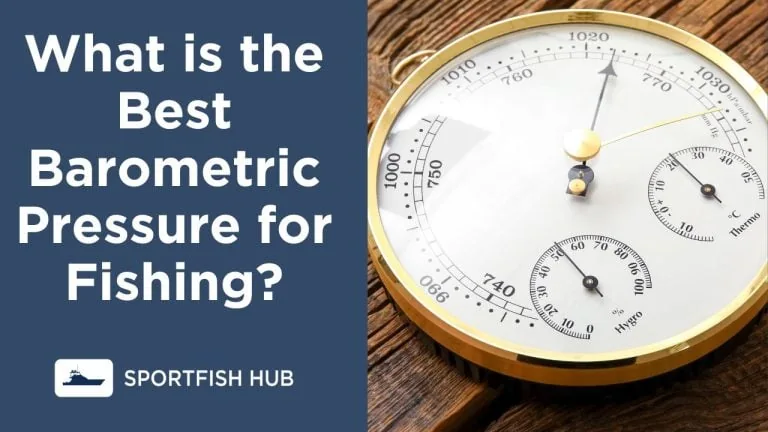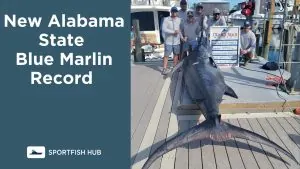Fishing is an art that requires patience, skill, and a deep understanding of various factors that influence fish behavior.
One such factor that often goes unnoticed is barometric pressure. But what is the best barometric pressure for fishing? Let’s dive deeper into this topic.
The Impact of Barometric Pressure on Fishing
Rising Pressure
As the barometric pressure rises, indicating improving weather conditions, fish tend to move around cover and in lower depths. However, they become lethargic once the pressure tops out. This is a crucial time for anglers to adjust their strategies and aim for deeper waters.
Falling Pressure
When the barometric pressure starts to drop, fish sense an oncoming storm. This triggers a more aggressive feeding behavior as they understand that feeding during low-pressure periods can be challenging. It’s during these times that fish are likely to bite, making it an excellent time for fishing.
High Pressure
High barometric pressure typically means clear skies and calm weather. During these periods, fish tend to be less active, making them harder to catch. They feel more secure and are less likely to move around in search of food.
Low Pressure
Conversely, low barometric pressure often means cloudy skies, wind, and potentially stormy conditions. These conditions can trigger increased feeding activity among fish, making them more active and aggressive. It’s another opportune time for anglers to cast their lines.
The Best Barometric Pressure for Fishing
The best barometric pressure for fishing is generally during periods of falling pressure and low pressure. These are the times when fish are most active and aggressive in their feeding behavior. However, it’s essential to note that these are general guidelines. The effects of barometric pressure on fish behavior can vary depending on the location, species, and other factors.
Barometric Pressure For Fishing Chart:
| Barometric Pressure (inHg) | Fishing Condition | Explanation |
|---|---|---|
| < 29.60 | Poor | Fish are less likely to be active and feeding. They tend to stay in deeper water and are less likely to be lured by bait or lures. |
| 29.60 – 29.70 | Fair | Fish activity begins to increase. They start to move to shallower water and show more interest in food. |
| 29.70 – 29.80 | Good | Fish are active and feeding. They are likely to be found in shallower water and are more likely to respond to bait and lures. |
| 29.80 – 29.90 | Very Good | Fish are very active and aggressive. They are likely to be found in shallow water and are highly responsive to bait and lures. |
| > 29.90 | Excellent | Fish are extremely active and aggressive. They are likely to be found in very shallow water and are highly responsive to bait and lures. |
Understanding the Impact of Barometric Pressure on Fish Behavior
How Barometric Pressure Affects Conditions
Barometric pressure, also referred to as atmospheric or air pressure, plays a crucial role not only in weather patterns but also in fish behavior and fishing success. Understanding the impact of barometric pressure on fishing requires delving into its influence on various conditions.
- High-Pressure Weather Systems: These systems are associated with clear skies and stable air masses, creating calm conditions that favor certain fish species, such as largemouth bass, walleyes, and crappies.
- Low-Pressure Systems: Low-pressure systems bring cloudy skies, precipitation, and increased winds, resulting in more dynamic water environments. Such conditions can stir up sediment particles and disrupt the distribution of zooplankton and phytoplankton.
- Direct and Indirect Effects: Barometric fluctuations have direct effects on fish behavior, impacting factors like temperature and oxygen levels. Additionally, these fluctuations indirectly influence surrounding ecosystems, contributing to the overall influence of barometric pressure on aquatic environments.
How Fish Behavior Changes With Pressure Fluctuations
Fish, like humans, possess pressure-sensing systems that detect subtle fluctuations in barometric pressure. These changes can significantly influence their behavior patterns and feeding habits.
- Detecting Weather Changes: Fish rely on the lateral line, a unique organ running along their body, to sense shifts in air pressure. Sudden drops in atmospheric pressure often indicate approaching storms or unstable weather conditions.
- Fish Behavior and Barometric Pressure: Different fish species exhibit varying responses to barometric pressure changes.
- Active During Falling Pressure: Anecdotal evidence suggests that species like largemouth bass become more active when barometric pressure drops.
- Sensitivity to Rising Pressure: Species such as walleyes tend to be more sensitive and display heightened activity during rising air pressures.
The Impact of Pressure Changes on Fish Feeding Patterns
Changes in barometric pressure can lead to discomfort among fish, resulting in decreased activity levels and altered feeding behavior. However, certain low-pressure systems, like stormy weather or cold fronts, may trigger more aggressive feeding behaviors among some species as they sense potential food shortages ahead.
Tracking Barometric Pressure for Fishing Success
To optimize fishing strategies and increase the chances of success, anglers can monitor changes in barometric pressure using fishing apps or barometers, as well as by considering weather forecasts.
- Using Apps or Fishing Barometers: Anglers can leverage technology to track barometric pressure and make informed decisions. Here are some ways to utilize apps or fishing barometers:
- Download barometric pressure apps on smartphones or tablets to track real-time pressure changes and access weather forecasts, helping anglers plan their fishing trips accordingly.
- Invest in fishing barometers that can be attached to gear or clothing for portable real-time monitoring of barometric pressure.
- Check online for barometric pressure charts that depict fish activity in relation to different pressure conditions, offering valuable insights for planning successful fishing outings.
- Utilize weather apps that provide detailed information about atmospheric pressure, wind speed/direction, temperature, and other relevant factors that affect fish behavior.
- Monitoring Pressure Trends: Before embarking on a fishing trip, it’s essential to monitor the trends of barometric pressure and choose the optimal time based on the desired outcome. For example, falling pressure before a storm can produce better fishing results.
Barometric Pressure Forecast
If you are planning a fishing trip and would like to check on the Barometric Pressure Forecast in your area, check out the Barometric Pressure App, where you can check the forecast by simply entering your location.
FAQ
Are there any fishing tips specific to different barometric pressure conditions?
Different barometric pressure conditions may require adjustments in fishing techniques. For example, during falling pressure, using lures that mimic injured prey might be effective, while during rising pressure, slower presentations could yield better results.
Can weather forecasts help predict barometric pressure changes?
Yes, weather forecasts often include information about barometric pressure trends. Monitoring these forecasts can provide anglers with insights into potential changes in pressure and guide their fishing plans accordingly.
Are there recommended fishing times based on barometric pressure?
While there are no definitive rules, many anglers find that falling barometric pressure before a storm or during unstable weather conditions can increase fishing activity and improve their chances of success.
Conclusion
In conclusion, barometric pressure plays a crucial role in fishing. By understanding its effects on fish behavior, anglers can make informed decisions and increase their chances of a successful catch. So, the next time you plan a fishing trip, don’t forget to check the barometric pressure. Happy fishing!













